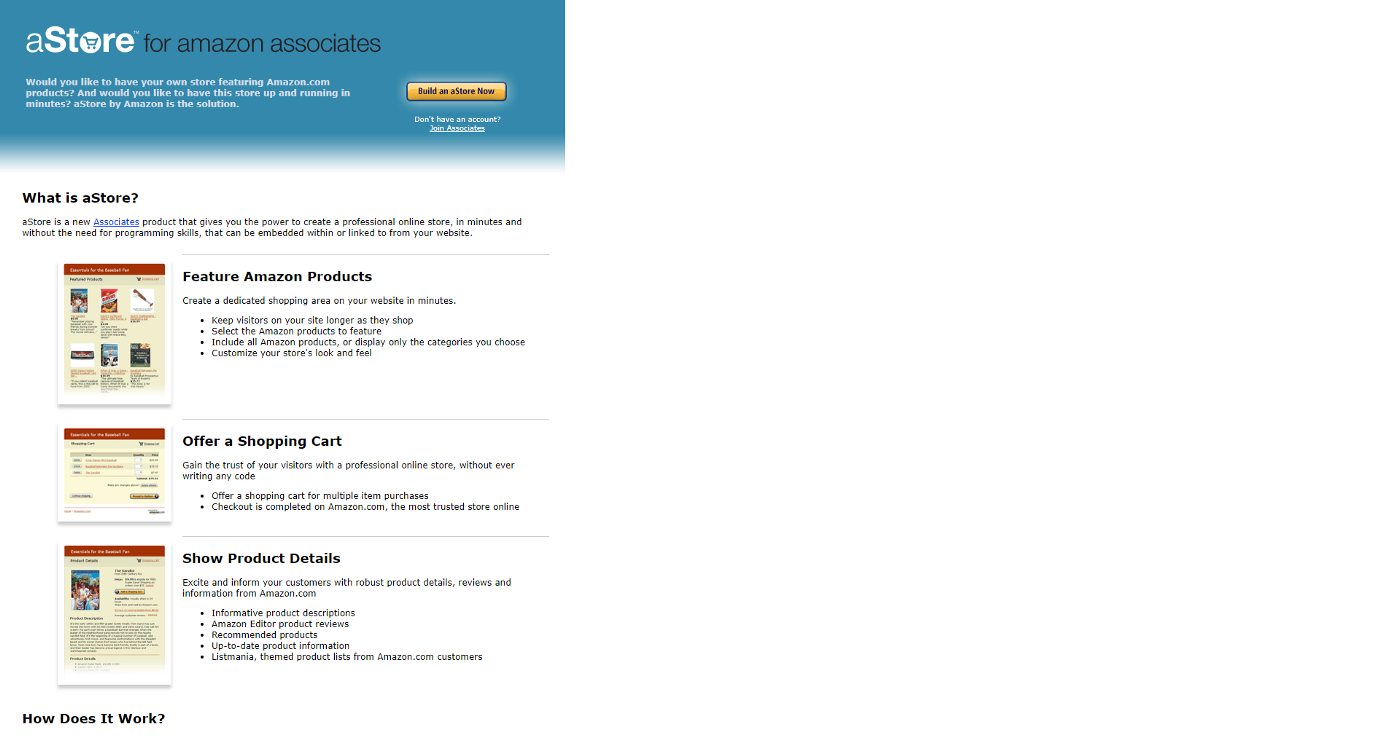A moment of silence for the “retiring” of Amazon’s aStore, which is set to take place by October 27th of this year.

Ok, moment’s over. Now, what the heck is Amazon’s aStore? Well for a short time, you can still read about it on Amazon’s site. But just from how the page looks, you can see that it’s ancient.

In short, it was an affiliate marketing program launched in 2006 that let website owners place a curated mini Amazon store on the site. You pick the featured items, display the aStore with said items, Amazon handles the transactions, and you get a cut.
It might have worked for a while, but the aStores haven’t performed well both for users and for Amazon in quite some time. According to their Retirement Fact Sheet, “only 25% of active aStore pages actually lead to Amazon.com product sales.”
So what can we learn from the shuttering of this affiliate model?
1. Affiliate marketing has changed a lot in 10 years.
2006 doesn’t seem that long ago, but it is in internet years. Remember, the iPhone didn’t debut until a year later. Mobile traffic was barely a thing then, but now is the majority of all traffic. And this fact is highlighted in the Retirement Fact Sheet: “aStore pages are not responsive and does not render well on various mobile devices.”
Another big change is that we have all gotten much savvier as browsers and shoppers. Back then, being able to order online was a novelty. So if you visited a GeoCities website that had product recommendations, that might be all you needed to mail out a check (that’s how online shopping worked back then, right?). But today, affiliate marketing is much more dependent on good content that will convince visitors that a) the influencer can be trusted, and b) the product being recommended is actually worthwhile.
In short, aStores were passive ways of hawking products. Today, great affiliates have to work harder than that to convert a sale.
2. Bad tracking/attribution = little use
Today, even the least savvy bloggers understand basic analytics. The beauty (and terror) of the internet is that you can track almost any metric. The best affiliates keep a close watch on their analytics in order to optimize their content for the best ROI.

The aStore is old tech. Because of that, it had trouble tracking visitors because it couldn’t set session cookies, leading to missed attributions. For the modern era of affiliate marketing, that simply doesn’t fly.
And if you can’t tell if it’s working or not, you’re not going to use it. This is another reason why aStore usage fell off, and why metrics are so important to both the merchants and to the publishers on current platforms. The bottom line is that analytics are the keys to success, and you should never settle for software that can’t tell you what’s working and what’s not.
3. Relying on someone else’s platform comes with risks.
Amazon isn’t wrong to shutter the aStore product. Usage is low and there hasn’t been any outcry from their associates who have moved on to their newer platform (Amazon Associates). However, as stated above, there are active aStores that are still making money for a small portion of users. And in a week or so, that will be gone.
It’s small potatoes in this case, but it is a sobering fact: relying on an external platform comes with inherent risks, namely, it could shut down at any time. You’re at the mercy of what Amazon deems worthwhile or not, and that’s a little unnerving if you rely on affiliate marketing income.
Likewise on the merchant side, if a large portion of your affiliates were using aStores to point to your products, now you’ll have to make sure they are ready with a new approach. It might even be wise to consider starting your own internal affiliate program so you won’t have to depend on the whims of a giant corporation like Amazon.
4. Amazon has bigger fish to fry.
Speaking of what Amazon chooses to focus on, they too are getting in on modern affiliate marketing by courting social media influencers to market products (currently just YouTube creators).

While Amazon’s associate program is for the masses, it’s clear they are also spending a lot of calories to ensure that the biggest influencers start working with them. The takeaway here? If you’re looking to reach out to influencers in your niche, you better do it sooner than later. Amazon is coming for them, and it has deep, deep pockets.


